flooding
Beavers Are Back in London — and They’re Thriving
The clues are unmistakable. A muddy embankment is covered in webbed, triangular footprints. A tree’s bark has been gnawed on one side, exposing the pale innards of its trunk. But the real giveaway is the thick dam made of branches that’s blockading a stream.
This site may be in London, a bustling metropolis of nine million people dominated by concrete high-rises and traffic-filled main roads, but it is now under the management of a new, or at least returning, critter on the block: the Castor fiber, or Eurasian beaver.
“The beavers absolutely love it here,” says Nadya Mirochnitchenko, an ecologist and coordinator for Ealing Wildlife Group, a volunteer-run community organization that is leading a scheme to reintroduce them. “In fact, they are getting kinda chubby.”
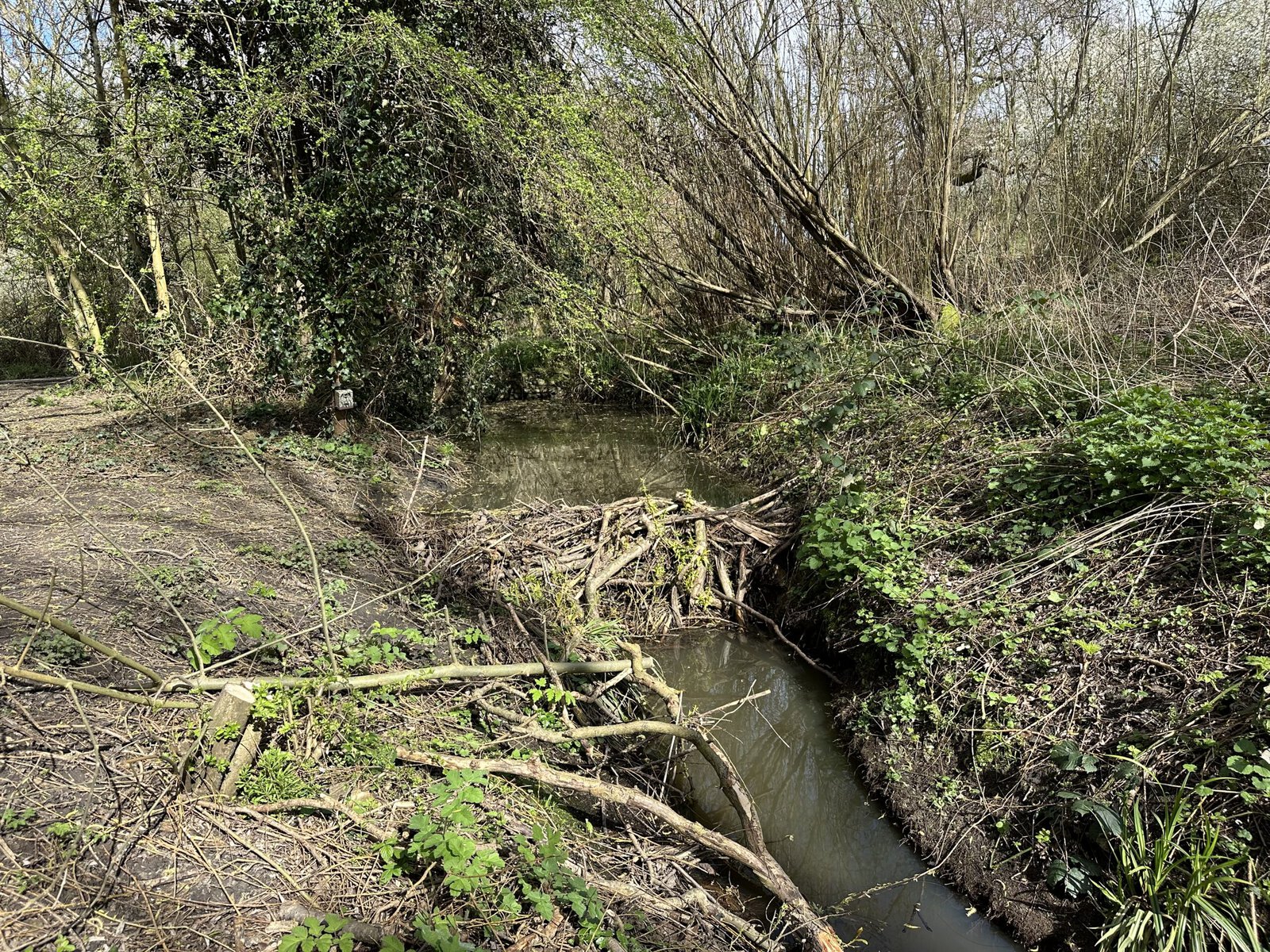 A dam built by the beavers. Credit: Peter Yeung
A dam built by the beavers. Credit: Peter Yeung
Beavers were hunted to extinction in England during the Elizabethan times, in the 16th century. But last October, these stout, furry rodents were reintroduced into London for the first time in 400 years as part of an effort to rewild the city.
The family of five beavers — a breeding pair and three offspring — were transported from Scotland by the Beaver Trust, a UK-based nonprofit, and released in Paradise Fields, a leafy, eight-hectare public park in West London, at an event attended by the mayor of London.
“Beavers are a keystone species,” adds Mirochnitchenko. “That means they have a disproportionately large impact on ecosystems. They alleviate flooding, they boost biodiversity, they keep everything in check. They’re like ecosystem engineers.”
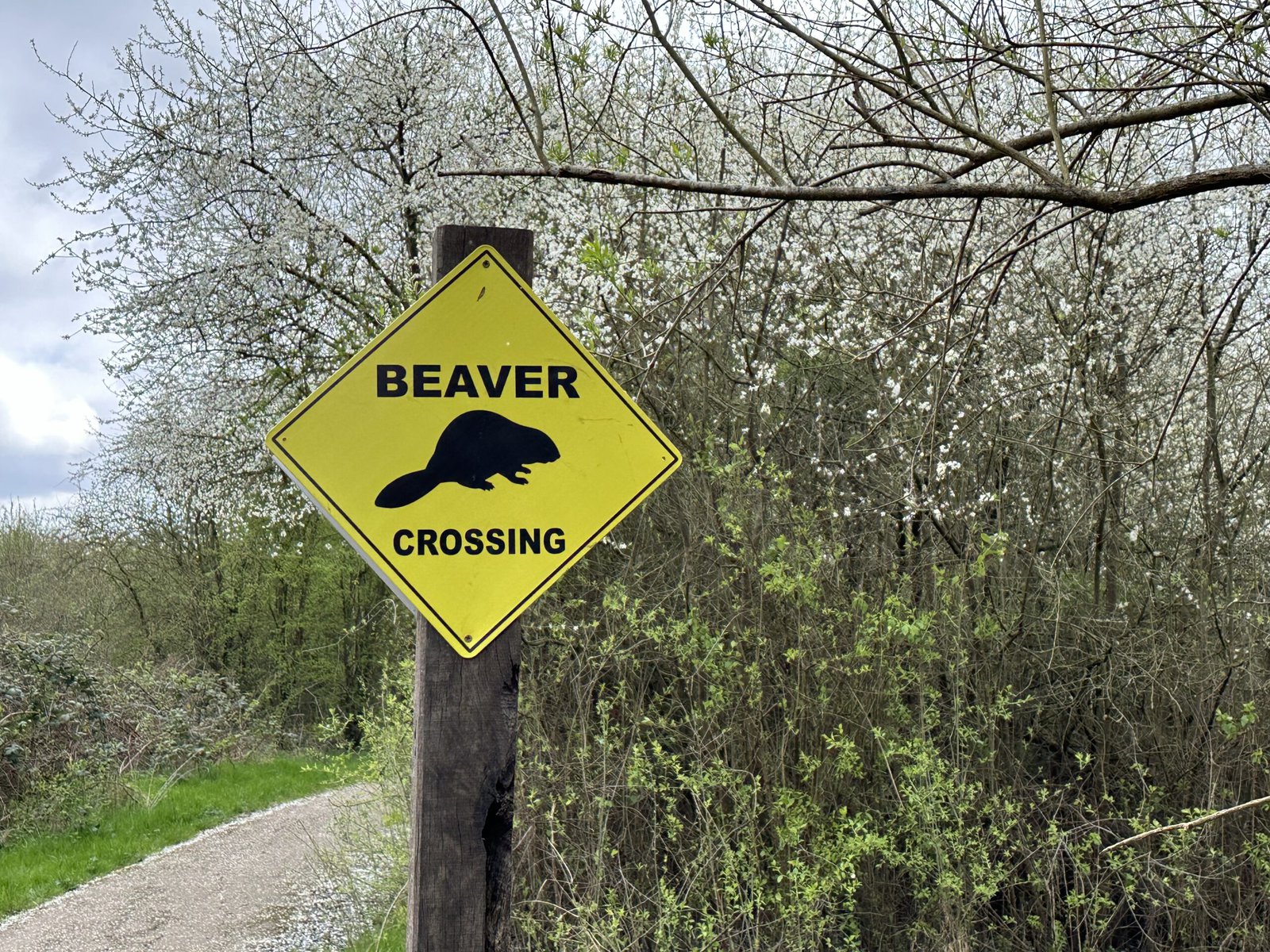 A sign in Paradise Fields. Credit: Peter Yeung
A sign in Paradise Fields. Credit: Peter Yeung
Ecologists say that beavers help biodiversity thrive because they instinctively build dams, dig canals and create deadwood to feel safe, which creates diverse habitats for other wildlife, such as water voles, dragonflies, amphibians, birds, reptiles and fish.
Few animals can modify and shape their surrounding environments to this extent.
But beavers bring a host of other benefits too: Their dams filter water, their instinctive maintenance of trees and shrubbery prevents them from overgrowing, and their reintroduction is a low-cost way of restoring wetland habitats — which store carbon, offer green space for locals, cool the environment and mitigate the increasing risk of flooding as the planet rapidly heats.
In fact, the brook that runs through Paradise Fields often overflows, in turn regularly flooding the nearby road junction and shopping mall. London authorities initially planned to build an expensive flood defense system — until the beavers came in.
Credit: Peter Yeung
“Beavers are a keystone species. That means they have a disproportionately large impact on ecosystems. They alleviate flooding, they boost biodiversity, they keep everything in check. They’re like ecosystem engineers,” says Nadya Mirochnitchenko.
Dr. Sean McCormack, chair of the Ealing Wildlife Group, says that although scientific studies are still underway, the beavers have already had an “anecdotal” impact. “A few weeks after they came, there were two massive storms that led to floods,” he says. “But three or four months later, there were more storms, and the same storm drain was only trickling. It’s because the beavers have built dams to slow the flow.”
The efforts in London are part of a trend of reintroductions across England in recent years, with beavers now in the counties of Kent, Cornwall, Devon, Derbyshire and Oxfordshire. A 2020 study of four sites across the country found the introduction of beavers led flood flows to decrease by up to 60 percent. Separate research found that there was 73 percent less sediment, including pollutants, in water downstream of beaver ponds. And a report released in March also found beavers in one project cut the impact of flooding and drought by storing three million liters of water in five years. “We are delighted that the beavers have thrived and improved the landscape,” said Matt Butcher, an Environment Agency representative, at the time.
Crushed by negative news?
Sign up for the Reasons to be Cheerful newsletter.
[contact-form-7]
Taking the beaver-led approach to flood mitigation could have a significant financial benefit: The local council had earmarked Paradise Fields area for engineering works that would have cost hundreds of thousands of pounds, according to McCormack, whereas the beaver project that replaced it cost just £45,000 ($56,000) for the infrastructure such as fencing and a feasibility study. Between 2015 and 2021, the UK spent £2.8 billion ($3.5 billion) on flood defenses, with that sum set to double over the six subsequent years.
The London project, which is supported by the London Beaver Working Group and Natural England’s National Beaver Officer, comes after the English government classified beavers as a native and legally protected species in 2022, following Scotland’s move to do so in 2019.
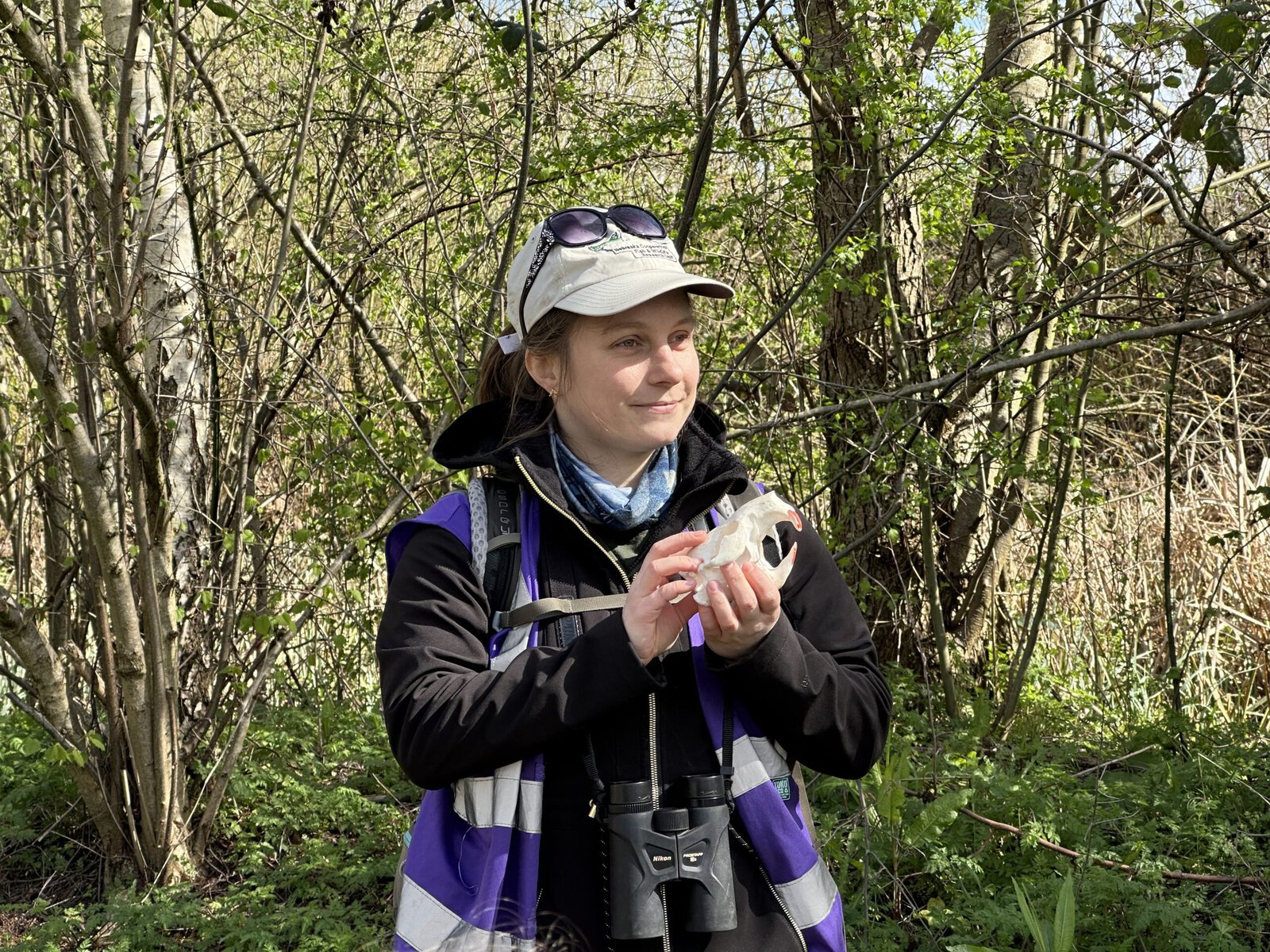 Nadya Mirochnitchenko holding a model beaver skull. Credit: Peter Yeung
Nadya Mirochnitchenko holding a model beaver skull. Credit: Peter Yeung
The mayor of London’s Rewild London fund, launched in 2023, has provided £2.4 million ($3 million) to projects across the capital and has helped to create or restore around 350 hectares of wildlife habitat, including pollinator corridors, wildflower meadows and the Ealing Beaver Project.
Experts say that while rewilding efforts have in the past targeted rural areas due to land availability and the relatively few legal and bureaucratic obstacles, cities are increasingly seen as playing an important part in tackling the biodiversity crisis.
“The rewilding movement has really been growing in the past three to five years,” says Sara King, a manager at Rewilding Britain, a nonprofit advocating for the return of wild nature spaces. “Traditionally, it’s been focused on rural areas. But recently, we’re shifting towards urban areas and London is definitely leading the way.”
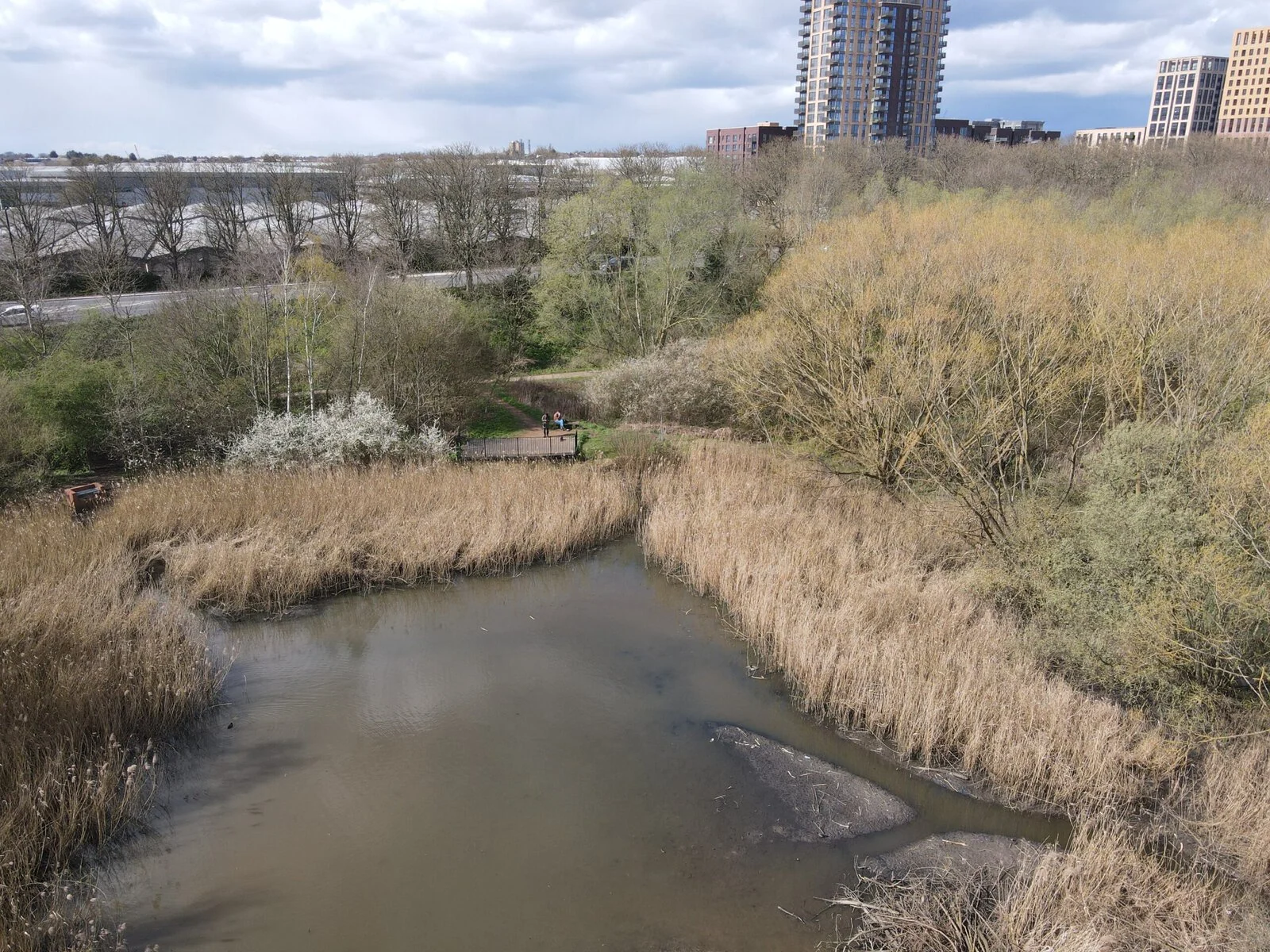 The brook that runs through Paradise Fields often overflows, flooding nearby areas. Already, the beavers’ work has slowed the flow from recent storms. Credit: Peter Yeung
The brook that runs through Paradise Fields often overflows, flooding nearby areas. Already, the beavers’ work has slowed the flow from recent storms. Credit: Peter Yeung
The 2023 State of Nature report found that 151 of 10,008 UK species assessed have become extinct since 1500 and that the UK is in the bottom 10 percent of countries for remaining native biodiversity. In order to address that decline, the government last year pledged to restore biodiversity in 30 percent of UK habitats by 2030.
“What we have to remember is that we’re one of the most nature-depleted countries in the world,” adds King. “But rewilding is really starting to build momentum. And the Ealing Beaver Project is an ambitious part of that.”
One of the key issues going forward will be managing the relationship between the beavers and local community. The beavers in London were removed from their home at the River Tay in Scotland because they were raiding crops from local farmers and causing fields to flood due to their dams. That won’t be an issue in London, but there still are other problems: For one, some members of the community damaged the metal fence installed around the park as they thought entry was being limited, even though there are several gates to enter.
Credit: Peter Yeung
“The rewilding movement has really been growing in the past three to five years. Traditionally, it’s been focused on rural areas. But recently, we’re shifting towards urban areas and London is definitely leading the way,” says Sara King.
“Community engagement is going to be key,” says Mirochnitchenko. The project continues to promote accurate information about beavers (a common misbelief is that beavers eat fish, when in fact they are herbivores) and so-called “Beaver Safaris” touring the site will begin this summer for eager members of the public.
But there have already been lessons learned from other beaver projects about how to deal with such issues, according to Ben Goldfarb, author of Eager, a book charting the history of beavers, which once numbered in their hundreds of millions in the US and were the subject of worship by Native American communities.
“Beavers aren’t like wolves or lynxes [or] like other species,” says Goldfarb. “They will live where we let them live. There are beavers in Seattle, New York City and Copenhagen. There are great examples of communities learning to coexist with beavers.”
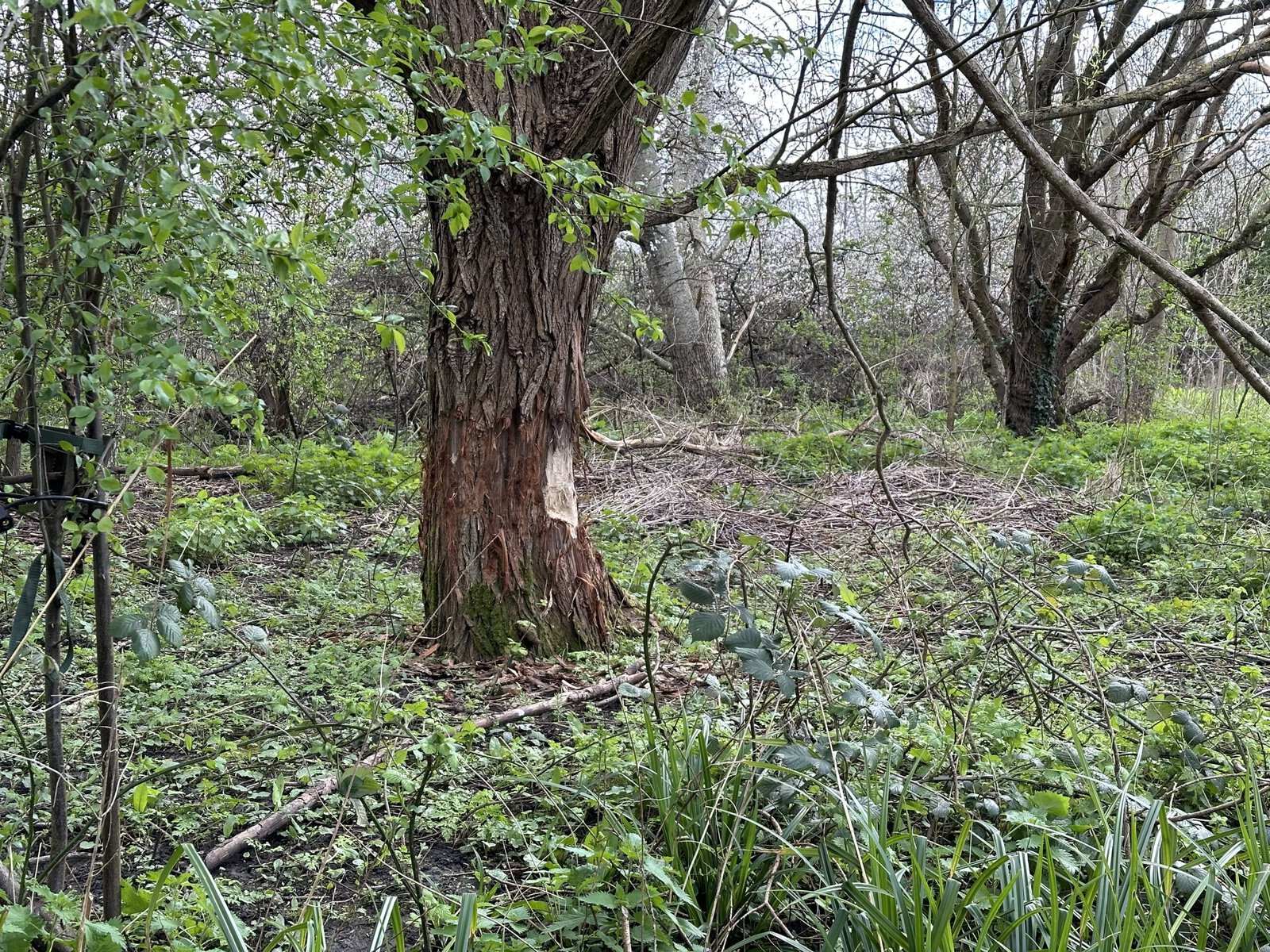 A tree gnawed by beavers. Credit: Peter Yeung
A tree gnawed by beavers. Credit: Peter Yeung
Bavaria, Germany, has an army of 1000 “Beaver Consultants” based in rural areas who work with local farmers to minimize conflict, and the government provides compensation for farmers who suffer damages. Other countries have shown great success with reintroductions: Sweden has over 150,000 beavers thanks to an effort that began a century ago. Norway reintroduced them in the 1960s and now has a population of 80,000; the US has over 10 million.
“It’s an amazing success story,” adds Goldfarb. “Beavers are one of the world’s most influential species. And in many cases, they manage ecosystems better than we do.”
And in any case, on the whole the London project has widespread support from locals. There are over 100 volunteers involved in the scheme, contributing to litter picking, patrolling of the fences, managing camera traps and surveying.
“One of the positive things is the overwhelming reaction of the public to the project,” says McCormack. “It’s captivated hearts and minds. It’s engaged communities.”


Become a sustaining member today!
Join the Reasons to be Cheerful community by supporting our nonprofit publication and giving what you can.
Another gnawing concern for the pro-beaver camp is that government policy is still lagging behind. Technically, the beavers in London are semi-captive. Though the area they occupy is open to the general public, the beavers are being kept behind a 1.25-kilometer-long fence, because fully-wild releases are not yet permitted in England, unlike other countries.
“It’s frustrating,” says McCormack. “We need to welcome them back into the towns and cities. Nature doesn’t just belong in the countryside.”
In the meantime, the beavers of London, in their refreshing oasis amid the Big Smoke, are doing their part to prove his argument. And if there is successful mating, the space will be large enough to eventually host three more families.
“Britain is the next frontier of beavers,” says Goldfarb.
The post Beavers Are Back in London — and They’re Thriving appeared first on Reasons to be Cheerful.
Landfill’s Toxic Legacy
Seven-year-old Zane Gbangbola and his family lived in a semi-detached Victorian house in Chertsey, Surrey, between the River Thames and what appeared to be an attractive lake, just the other side of the field that their home backed onto. To all appearances, it was an idyllic spot in a desirable greenbelt location.
Zane’s parents, Kye and Nicole Gbangbola, were both successful young professionals and their only child was a bright, lively boy, popular at his school and in the church community to which Kye and Nicole belonged.
But in January and February 2014, the heaviest rainfall since Met Office records began – the first climatic event attributed to climate change by a UK prime minister – showed the grim downside of living so close to water for many thousands of people in southern England.
Homes were inundated from Cornwall to Kent, rail lines were washed away and, on 5 February, amid mounting criticism that the Government was failing to get to grips with the crisis, Prime Minister David Cameron held the first of a series of COBRA meetings.
Two days later, in the early hours of 8 February, the happy lives of Zane and his family were shattered forever.
Kye and Nicole’s home had never been inundated before, and it had a flood basement designed to protect from this risk. As the torrential rain continued in that first week of February, this was doing what it was meant to do – collecting floodwater that had overflowed from the nearby lake, which Kye and Nicole were pumping out with electric pumps. They had also hired a petrol-driven pump, but only used this for a short period in the morning of 7 February to set it up and test that it would work if needed as a back-up.
All members of the family had been feeling unwell in the previous few days, but believed this was due to seasonal infections.
That evening, Kye took Zane with him to a local residents’ meeting calling for councillors to do more to protect vulnerable residents from the impacts of flooding. Afterwards, they returned home and Zane enjoyed the treat of watching the opening ceremony of the 2014 Winter Olympics on TV.
After he had been put to bed, Kye used the bedroom next to his son’s to work on his computer. He and Nicole were taking it in turns to be on “floodwatch” during the night, to check that the electric pumps were working to protect their home.
At around 3.30am, Nicole checked on Zane and found he was not breathing. She tried desperately to resuscitate him while waiting for an ambulance but neither she nor the paramedics could revive him. Zane was pronounced dead in hospital a short time later.
A second ambulance crew found Kye unconscious and in cardiac arrest in the room where he had been working, less than two metres from Zane’s room. He regained consciousness in hospital but had lost all sensation and power in his legs. Kye was later told that he would never walk again.
Hydrogen Cyanide
Exactly what caused Zane’s death and left his father in a wheelchair was, two-and-a-half years later, the subject of an inquest that many now believe failed to properly examine the strong evidence that points towards a deadly chemical culprit: hydrogen cyanide, conducted into the family's home along with water from the nearby lake that had, unbeknown to them, previously been a landfill site for all manner of waste materials.
The coroner found that, “on the balance of probabilities”, Zane was killed by carbon monoxide from the petrol-driven pump, despite Kye and Nicole’s denials that this was used that night – and despite the fact that officers of Surrey Fire and Rescue Service’s specialist HAZMAT team, which arrived at the family’s home at 4:30am that morning, found that the pump was cold and showed no sign of recent use.
The HAZMAT team detected no unusual levels of carbon monoxide within the house, but its specialised equipment did detect hydrogen cyanide at potentially dangerous levels – not once but three times.
Several other anomalies throw doubt on the coroner’s conclusions.
The carbon monoxide found in Zane’s blood was well below levels that would normally be fatal or cause serious symptoms. The Environment Agency national incident recording system classified the 25,000ppm reading for hydrogen cyanide, as reported by the fire crew, as "very high", and Kye and Nicole were advised not to return to the house for over a year, even to collect belongings. And in July 2014, a leading neurophysiologist ascribed Kye’s paralysing condition as being “due to hydrogen cyanide”.
Since 2014, Kye and Nicole have fought tirelessly for a full, independent panel inquiry into what happened that night. They have gathered an impressive body of evidence as well as support from unions including the Fire Brigades Union, the Communication Workers’ Union and UNISON, environmental scientists, local councillors, and many prominent politicians including Keir Starmer, Andy Burnham, David Lammy, Jess Phillips, Jeremy Corbyn and Caroline Lucas.
A petition by the 'Truth About Zane’ campaign calling for an independent investigation has been signed by 118,000 people.
Earlier this month, an Early Day Motion signed by 32 MPs called for an independent panel inquiry with full powers to compel disclosure into Zane’s death. It noted that “the victims and bereaved in this case have been blamed, abused and scapegoated” and that there had been a “lack of proper investigation” with “masses of evidence undisclosed or ignored and a flawed judicial outcome”.
The MPs also drew attention to a particularly shocking aspect of the case: “Zane’s family were refused legal aid for his inquest, whilst legal support for public officials was paid from the public purse and the coroner received legal aid.” This denial of so-called 'parity of arms’ meant that Zane’s parents have been faced with a steeply unlevel playing field in legal terms.
'Ticking Time Bombs’
During the past few years, evidence has emerged that strongly suggests the landfill site next to the family’s home, which had later been turned into that pretty lake, had previously been used to dispose of highly toxic material.
In 2020, a Ministry of Defence whistleblower told the BBC that chemical waste from an MoD research facility had been dumped in metal drums into gravel pits around Chertsey, including the one from which floodwater entered Kye and Nicole’s home.
This tallied with evidence uncovered in planning documents for an aviation fuel pipeline, which revealed that a borehole sunk into the gravel pit in 1972 (before it was flooded later that decade) had struck “a metal canister... which released a substance that effervesced with water in the borehole and gave rise to an 'obnoxious smell’”.
What happened to Zane and his family in 2014 also highlights a growing danger faced by many others who live near old landfill sites.
In 2021, independent environmental analysts the ENDS Report found that there are around 21,000 such sites across England and Wales. Of these, 1,287 are categorised as containing waste that would be hazardous to human health if it escaped. Very few of these sites are known to have been properly lined to stop residues being released.
An earlier government study into the link between birth defects and proximity to landfill sites found that 80% of the British population lives with two kilometres of such a site (it also found that incidence of birth defects and low birth weight increased with proximity, though causation could not be established with certainty).
Mapping by the Ends Report shows that 9% of such potentially dangerous sites lie directly under housing and 4% under commercial areas containing shops and restaurants. A further 45% of such sites are under green spaces or parkland. Nearly 750 are within 500 metres of bodies of water and 1,364 are in zones at risk of tidal flooding.
Like Zane’s family, most people who live close to these sites have no idea that they are there or of the potential dangers they may pose. This is not surprising, as information about historic landfills is by no means easy to come by.
Although the Environment Agency keeps records, these are, by its own admission, “not detailed” and often it is simply not known what materials may have been buried within these sites. Nor, in many cases, is it clear who is responsible for making sure that they are safe.
Such landfills may contain anything from household waste to industrial sludge, asbestos, toxic mining waste, polycyclic aromatic hydrocarbons (linked to a range of cancers) and polychlorinated biphenyls (linked to altered thyroid and reproductive function and increased risk of cardiovascular and liver disease, and to diabetes). Some sites are even thought to contain toxic materials from the UK’s historic chemical weapons programme.
Dr Paul Johnston, a specialist in environmental toxicity at Exeter University’s Greenpeace Research Laboratories, has described these landfills as “ticking time bombs”, noting that: “With the climate crisis set to bring more flooding and coastal erosion to the UK, some of these sites are at even higher risk of leaking their toxic contents. This is a difficult and costly problem to tackle, but we're going to have to do it at some point, or there'll be some nasty surprises in store."
Earlier this month, it was revealed that research undertaken on “a number of different operational and closed landfills” for the Department for Environment, Food and Rural Affairs and the Environment Agency had found 17 of these to be leaking highly toxic substances containing banned and potentially carcinogenic “forever chemicals” – in some cases at levels 260 times higher than is deemed safe for drinking water.
Zane’s Law
As the Levelling-up and Regeneration Bill reached committee stage in the House of Lords last year, Green Party Baroness Natalie Bennett drew the attention of her fellow peers to plans to build homes on two former landfill sites known to have been used to dispose of highly toxic materials (in Coseley, near Dudley, and in the village of Somercotes in Derbyshire).
She sketched out the history of regulation of such sites, pointing out that “EU regulations on waste and pollution came in through the Environmental Protection Act 1990, tightening up controls. In particular, Section 143 provided an obligation for local authorities to investigate their area and draw up public registers of land that may be contaminated. Section 31 of that Act also gave local authorities powers to inspect and close landfills and clean them up if necessary”.
But, as the peer explained, these sections of the 1990 Act were never properly implemented, with the justification given for this being that it was about “the cost and desire not to place ‘new regulatory burdens’ on the private sector”. Later, the Cameron Government’s so-called “bonfire of red tape” had further reduced the right of authorities to use the law to enforce clean-up of these sites.
With this – and the horrific experience of Zane’s family – in mind, Baroness Bennett proposed an amendment to the Levelling-up and Regeneration Bill, which would place a duty on local authorities to report on land contamination in their areas, and for the Secretary of State to publish a nationwide review of the incidence of such contamination, identifying the resources and any legal changes needed to bring all potentially hazardous sites in England to safe levels.
Baroness Bennett proposed that this amendment be known as Zane’s Law.
It did not succeed in making it into the Act as passed but, with climate change driving an increasingly severe risk of flooding around such historic landfill sites, the need for stronger regulation is becoming ever more urgent.
“Surely, a basic duty of the Government is to ensure the security of people in their own homes, which, quite frankly, they are unable to do now because they are not empowering, directing and resourcing local authorities to ensure that they know what is in their land,” Baroness Bennett told the House of Lords.
This week, Zane’s parents have launched a petition for a change in the law, with Lewes Council becoming the first in England to pass a motion calling for a Zane’s Law.
Green Lewes councillor Imogen Makepeace said: “We hope that in passing this motion of support for Zane’s Law, our council will be paving the way for more local authorities to take up the call. Many thousands of people live near such potentially dangerous former landfill sites and are entirely unaware of the risks that they pose.”
Any change in the law will come too late for Zane and his family. But it can’t come soon enough for many others who face the growing risk from landfill’s toxic legacy.
A Ranch, Rewilded: The Transformation of California’s Next State Park
On a bright morning in early January near the confluence of the San Joaquin and Tuolumne rivers in Central California, John Cain looks out over a small, curved lake. The trees are mostly bare for winter, but Cain, senior director of conservation of the nonprofit organization River Partners, points out that the wild landscape in front of him is buzzing. Bright white egrets swoop lazily down into the water while terns whiz by in the air. A California rose bush clings onto bright red rose hips. The low-lying plain across the water is dense with gray branches of adolescent trees.
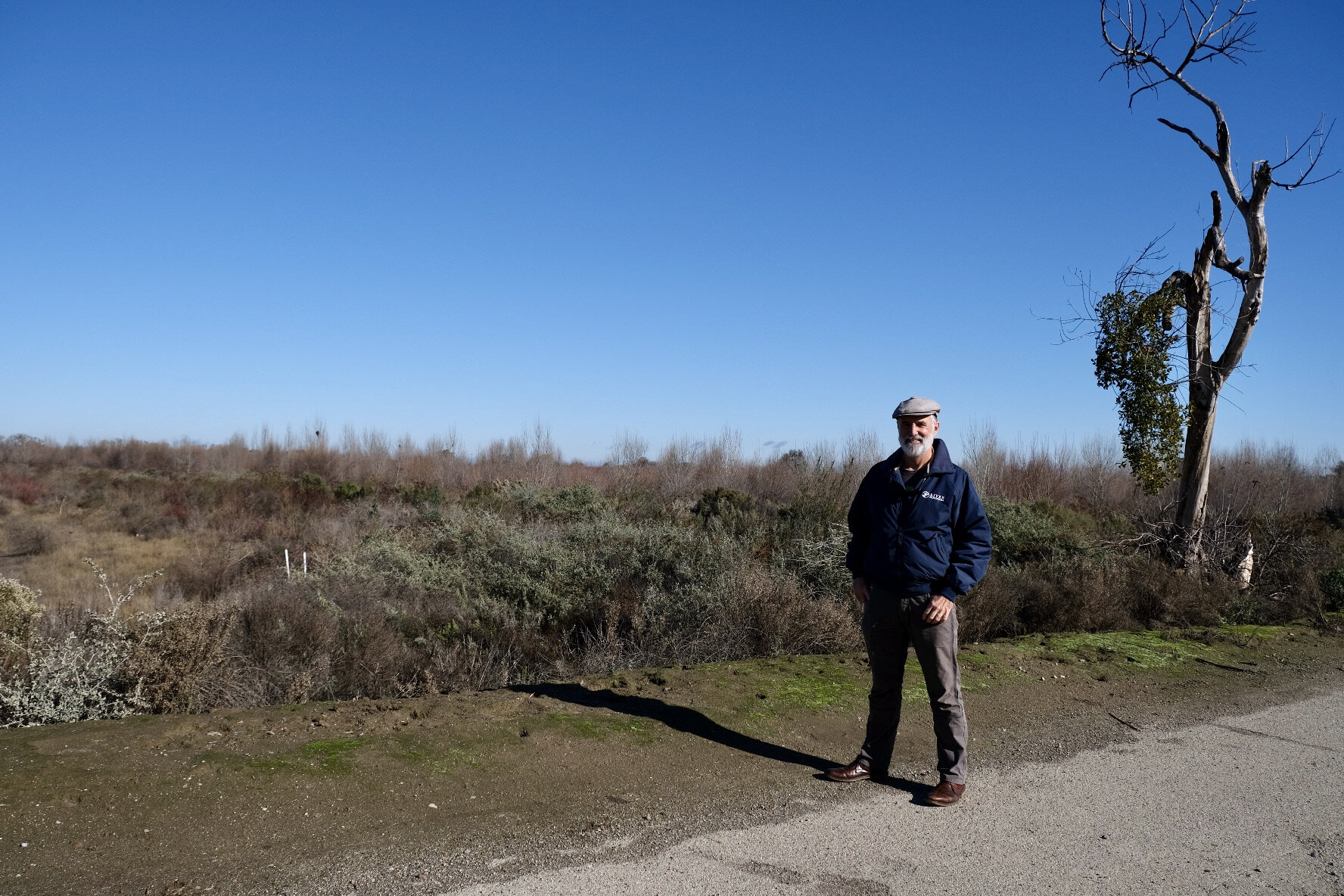 John Cain of River Partners. Credit: Elizabeth Hewitt
John Cain of River Partners. Credit: Elizabeth Hewitt
For more than four months last year, as California was inundated with a series of major storms, this part of Dos Rios Ranch Preserve, about 20 miles west of Modesto, was submerged under water. That’s exactly what it was designed for. And when the floodwaters recede, Cain says, “It’s just an explosion of life out here.”
Until a little more than a decade ago, this area was productive farmland, used for growing crops like tomatoes, alfalfa, melons and almonds. Now it’s set to be California’s next state park after a restoration project spearheaded by River Partners converted the ranch into rewilded riverside habitat. As climate change has doubled the likelihood of flooding in California, and is projected to increase runoff from storms by as much as 200 to 400 percent, this restored floodplain is proving to be a promising approach.
The post A Ranch, Rewilded: The Transformation of California’s Next State Park appeared first on Reasons to be Cheerful.